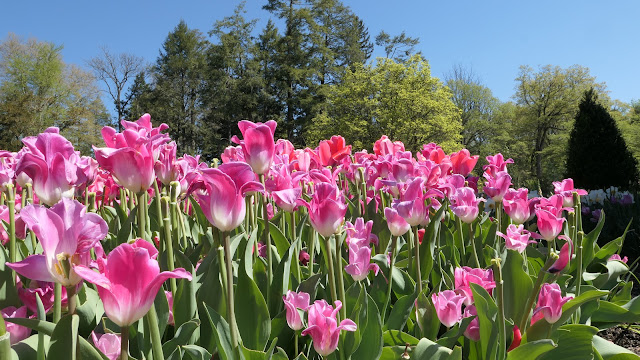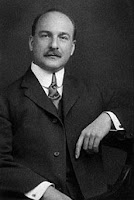Three days and five gardens in the Garden Capital of America
We left Virginia and traveled about three hours north passing through Maryland into Delaware and then Pennsylvania. It was Sunday which meant that the traffic was light although it seemed busy to this Rochester driver. We drove through downtown Wilmington on the way to our hotel in Glen Mills PA at the intersection of the Baltimore Pike (US 1) and the Wilmington Pike (US 202.) Happily enough our hotel was a stone's throw from a Wegman's where we did some travel shopping.
Over the next three days, we visited five gardens in the area. That seems like a lot but then the Greater Philadephia area is called the Garden Capital of America. There are 36 public gardens within a 30-mile radius of the city. We found ourselves in the area around Wilmington DE. Below are some photos, a video and some descriptions of five of those 36 gardens. We certainly got an early taste of spring after what seemed like a long, even endless winter.
Longwood Gardens
The next day we drove seven miles to Longwood Gardens where we spent the day. Longwood consists of over 1,077 acres of gardens, woodlands, and meadows in Kennett Square, Pennsylvania in the Brandywine Creek Valley. It is one of the premier horticultural display gardens in the United States.
Longwood Gardens has a long varied history. For thousands of years, the native Lenni Lenape tribe part of the Delaware Nation fished its streams, hunted its forests, and planted its fields. In 1700, a Quaker farmer named George Peirce purchased 402 acres of this site though not surprisingly he did not buy it from the Delaware. He bought it from William Penn's commissioners. Peirce and his descendants farmed the land. Around 1800 his twin grandsons became interested in horticulture and began planting an arboretum. By 1850, the arboretum boasted one of the finest collections of trees in the nation and had become a place for the locals to gather outdoors – a new concept that was sweeping America at the time. By the early 20th century the Peirce heirs lost interest in the property and the arboretum began to decline. In fact, by 1906 a lumberman was poised to cut down this magnificent collection for timber.
At that point, Pierre S. du Pont of that de Pont family stepped and purchased the property to preserve the trees. As the Longwood website states, "He was not planning to create Longwood Gardens, but within a few years, his desire to make it a place where he could entertain his friends transformed a simple country farm into one of the country's leading horticultural display gardens."
At that point, Pierre S. du Pont of that de Pont family stepped and purchased the property to preserve the trees. As the Longwood website states, "He was not planning to create Longwood Gardens, but within a few years, his desire to make it a place where he could entertain his friends transformed a simple country farm into one of the country's leading horticultural display gardens."
Longwood was operating under appropriate COVID-19 restrictions. We arrived at 10 AM opening time for our timed entrance reservations. We had to wait about 15 minutes for entry in a well-ordered line with masks and social distancing required. We spent the day walking through dazzling displays and woodland areas with spring flowers and flowering trees.
 |
| Columbine |
 |
| Winter Orchids |
Most botanical gardens have such displays but they also have naturalized areas of native plants which live their natural life cycle. In those areas, we see whatever would be blooming this time of the year in a meadow or woodland. The flowering trees are the most spectacular but there are many other plants, mostly small and unremarkable once their flowers are gone. The redbuds were in full flower and painted their subtle colors on the hillsides and over walking paths. You can click the photo to see a short video. These often have brilliant colors. We enjoyed both aspects of Longwood.
The most dramatic displays were the tulips, more than 200,000 throughout the entire garden. They came in multiple colors and shapes. Some were solid but others seemed translucent with the sunlight shining through. Longwood also has a large Conservatory with 4.5 acres--almost 200,000 square feet-- under glass with controlled environments. Many of these used hydrangeas especially in hanging baskets. Even these would eventually find their way to the compost site to become fodder for next year's displays.
The naturalized areas were very interesting. Our walks were punctuated with frequent discussions of what we were seeing. Marilyn used an app that uses a photo to identify a plant and we put it through its paces every few minutes.
Longwood is noted for many other features such as the formal Italian garden surrounded by little leaf lindens pruned in a dramatic fashion. There is a large formal fountain display next to the conservatory and a bell tower designed to look like a Medieval tower. You can view more photos of Longwood by clicking here.
Winterthur Museum, Garden and Library
We had visited Winterthur two years ago at the end of June. We spent half our time on a tour of the house which serves as a museum of American Decorative Art. This is the premier museum of American decorative arts, with an unparalleled collection of nearly 90,000 objects made or used in America since 1640. The collection is displayed in the magnificent 175-room house, much as it was when the family of founder Henry Francis du Pont family called it home.
 |
| Marilyn among azaleas |
“I sincerely hope that the Museum will be a continuing source of inspiration and education for all time, and that the gardens and grounds will of themselves be a country place museum where visitors may enjoy as I have, not only the flowers, trees and shrubs, but also the sunlit meadows, shady wood paths, and the peace and great calm of a country place which has been loved and taken care of for three generations.”
On our first visit, we experienced the 60 acre garden at the beginning of summer. We quickly realized that this was essentially a woodland garden. While it was lovely and engaging at that time of year, it would be in its glory in the spring. We almost timed our visit perfectly. Many of the azaleas were in bloom but sadly almost none of the rhododendrons were. It was the ground floor of the woodlands that was showing colorful blooms of all sorts: bluebells, worts of various kinds, trillium, wakerobins and more. Everything about the 60 acres was planned by Dupont. He meant for all parts of the garden to present a planned show throughout the seasons. So while the ground floor flowers were ones that you might find in any woodlands in the areas, these were placed in a master design depending on their color and timing of their blooms.
The best example was a circular plot with blooming trees in the center surrounded by beds of bluebells, trillium, celandine poppy and bloodroot so that the view changed as the viewer walked around the plot. We talked with one of the horticulturists working with a volunteer. They were removing unwanted plants from the design. You and I would call them weeds but she did not. After all, to her a weed was just a plant you didn't want in its current location. Many of the ones they were removing were invasive and if left alone would gradually take over the area and thus destroy the design. She made it clear that they did very little "editing" of the plantings, just enough to maintain Mr. Du Pont's original intent.
There is a wide variety of trees many of them quite old and large. The most dramatic was an ancient sycamore--over 250 years old-- that presided over a grove of redbuds in bloom. This area is called Sycamore Hill. While the redbuds were in bloom, the sycamore had not yet begun to leaf out. You can spot some of the redbuds just to the right. But speaking of redbuds in this area, they were spectacular.
Du Pont left nothing to chance. One of the last areas he designed was based on a sone quarry that was no longer in use. He chose plants carefully and designed a water system that created a wet bottom to accommodate plants habituated to that environment. From down in the Quarry Garden, you could look up to Sycamore Hill and its spring display.
 |
| From the bottom of Quarry Garden |
Jenkins Arboretum
Our third day in the Garden Capital of America began at the Jenkins Arboretum and Gardens in Devon PA about a thirty-minute drive from our hotel.
 |
| Pathway in Jenkins with azaleas coming into bloom |
The Arboretum was established by H. Lawrence Jenkins in 1968 as a living memorial to his wife Elisabeth Phillippe Jenkins. In his will, Jenkins designated that the 20-acre property become a "public park, arboretum, and wildlife sanctuary for use by the public and responsible organizations engaged in the study of arboriculture, horticulture, and wildlife for educational and scientific purposes". In 1972 Louisa P. Browning donated 26 acres (110,000 m2) of adjoining property to the Arboretum, more than doubling its size.
Early surveys of the property determined that the best plants to grow in the rocky, acidic soil would be those in the heath family (Ericaceae). Rhododendrons and azaleas were chosen as the primary collection. The Arboretum officially opened to the public in 1976 and today has one of the most significant collections of azaleas and rhododendrons in the country.
In addition to the Rhododendron collection, the Arboretum features numerous native trees, shrubs, ferns, and wildflowers that can be found in several different garden areas. The botanical diversity of the site also supports many varieties of wildlife. Foxes, turtles, hawks, small mammals, and nearly 100 species of songbirds frequent the Arboretum.
While again we were too early for the full display of the Rhododendron collection, we were able to see many azaleas and the small leaf rhodies in bloom. Unlike Winterthur where every space was planned and constantly edited, Jenkins seemed much more naturalized. This was particularly true of the ground floor. There were masses of celandine poppies which are native to the area and pretty aggressive but they provide a golden carpet of color for the showy displays of color from the azaleas and the rhodies. This was the third garden where encountered woodland ephemerals. I found this definition to be helpful: "Woodland ephemerals bloom, undergo pollination, and produce seed, all during a small window of time between snowmelt and when the trees leaf-out. The spring sunlight warming the woodland floor causes the plants to bloom. At the same time, the warmth stirs pollinating insects into action. The availability of spring flowering natives ensures that early pollinators have the nectar they seek in the critical period when they first emerge to forage."
The trails were well maintained and composed of rubberized material which clearly facilitated use by anyone with any mobility issues. This is particularly important because the site is mostly fairly steep hillsides. There were several offshoots of mulch so that you could disappear into masses of color.
This was envisioned as an arboretum and the tree inventory is impressive. The side benefit is that the trees provide exactly the perfect environment for the azaleas and rhodies which have become the point of distinction for this garden which is free and open to the public.
During our visit we met Steve Wright (r), the Director of Horticulture, and Gene McMillion (l), a Certified Arborist for Shreiner Tree Care. They were applying something to several plants in the garden including a hillside with very young plants. They were applying a pesticide to protect the azaleas from mealybugs which can destroy the plant if left untreated. It was a pyrethroid pesticide, an older and very safe pesticide. The hillside where we encountered them had been devastated by a severe storm last year and had to be completely restored.
The garden also includes a pond which provides an interesting foreground when the hillside is in full bloom. That wasn't the case yet but it was a nice panorama nonetheless.
Chanticleer, a Pleasure Garden
Chanticleer began as a summer home along the Philadephia Main Line for Adolph Rosengarten, Sr., and his wife Christine. The family drug firm eventually became part of Merck in the 1920's. By then Adolph had expanded the house and the family was using it as their primary residence. Eventually Adolph would gift his two children with homes located on the site, one of which is in ruins. The site stayed in the family until the death of Adolph Jr. in 1990 when a foundation assumed ownership and the site and its several gardens were opened to the public.
There is a lot of whimsy in this garden. The name comes from an 1855 Thackery novel, "The Newcomes." That estate, Chanticelere, was "mortgaged up to the very castle windows" but "still the show of the county." Since "chanticlere" means rooster, there are several rooster representations throughout the gardens. There is also a children's playhouse along a descending walkway that my childlike companion enjoyed.
Stoneleigh: A Natural Garden
Stoneleigh began as a 65-acre estate in Villanova PA. In 1908, the then owner retained the "Olmsted Brothers of Massachusetts—sons of Frederick Law Olmsted, and the most prestigious landscape architecture firm in the country—to “guide him in the gradual transformation of the place.” Over the next 50 years, the Olmsted Brothers firm returned periodically to Stoneleigh to plan vistas and pathways, establish gardens and terraces, reroute points of entry, select plant species, and transplant trees." In 1932 at the death of the owner, the property was divided and the southwest portion was acquired by Otto Haas, co-founder of Rohm and Haas. Otto continued the work of the Olmsted Brothers and in 1964 his son, John, and his wife Chara acquired the property and lived there for the next 50 years raising their five children. In 1996, John and Chara placed the property under conservation easement with Natural Lands. At John's (2011) and Chara's (2012), their children honored their wish that the property be preserved for the public and donated it to Natural Lands which operates it today.
 |
| Stoneleigh Home with London Plain tree, a type of sycamore, just coming into bloom |
Perhaps it was at the end of a long day but there was not a lot to see. If there were no pandemic, the house would be open for tours and that would have been interesting. The estate serves as an escape into a calm and beautiful landscape. It is free and always open to the public. It is right next to the Villanova University campus. Click here to view some photos of Stoneleigh.


















Comments
Post a Comment